STEM GIRDLER
Sthenias grisator
| Symptoms of damage |
- Wilting of branches and then the entire vine.
|
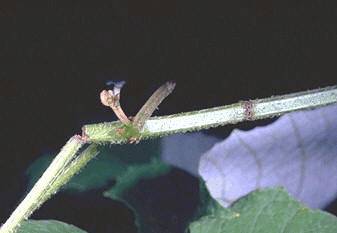 |
| Cane girdler injury |
|
| Identification of pest |
- Grub - Head is dark brown colour, pair of strong mandibles.
- Adult – Medium sized, grey coloured with a white spot in the center of each elytra.
|
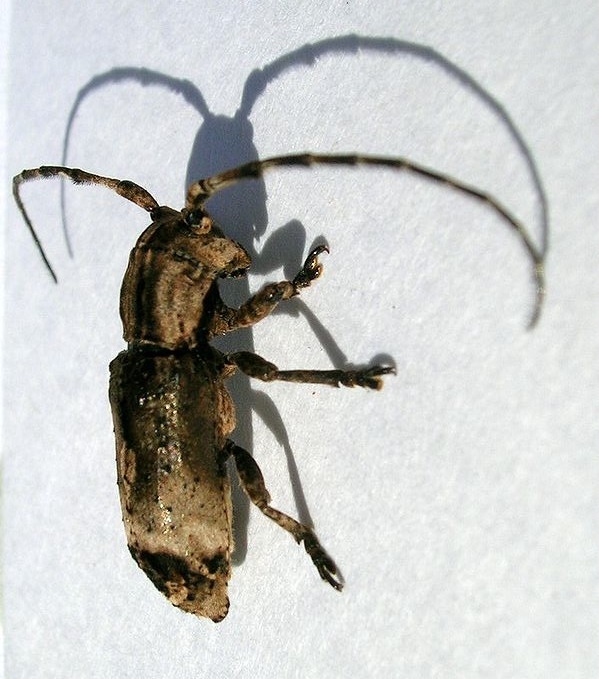 |
| Adult |
|
| Management |
-
Remove loose bark at the time of pruning to prevent egg laying
-
Collect and destroy damaged plant parts
-
Swab trunk with carbaryl 50 WP 2g/ lit
-
Spray application of anf following insecticides
- phosalone 35 EC 0.07%
- quinalphos 25 EC 0.05%
- carbaryl 50 WP 0.1%, first round immediately after pruning and repeat it 2-3 times
|
Grape vein beetle, Sinoxylon anale
| Symptoms of damage |
- Wilting of branches and then the entire vine
|
| Identification of pest |
-
Adult - dark-brown colour with 3 bladed antennae
-
pair of spines on the posterior end of the elytra.
-
Grub - fleshly, thick yellowish and white with curved body.
|
Top
LEAF FEEDERS
Flea beetle, Scelodonta strigicollis
| Symptoms of damage |
- Caused two type of damages
- Larvae and adults feed on the upper and lower leaf surfaces – leaf injury
- Adult feed on swollen grape buds
- Chew holes in the sides of the newly developing grape buds
- Small holes on tender leaves by adult
- Root damage by grub
|
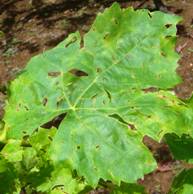 |
| Shot holes |
|
| Identification of pest |
- Adult - Reddish brown, shiny with six spots on elytra
- Grub – brown in colour and black colour head
|
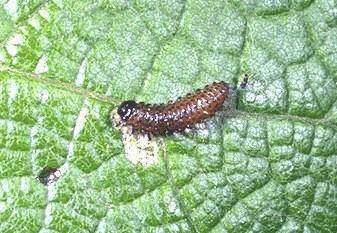 |
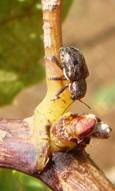 |
| Larva |
Adult |
|
| Management |
-
Remove the loose bark at the time of pruning to prevent egg laying
-
Shake vines to dislodge adult beetles
-
Collect into trays containing kerosenated water and destroy them
-
Insecticide: phosalone 35 EC 0.07% after pruning
|
Top
Leaf roller, Sylepta lunalis
| Symptoms of damage |
- Caterpillar - rolling of leaves.
- Scrabbing the chlorophyll content inside the leaf roll
- Skeletonization of leaves
|
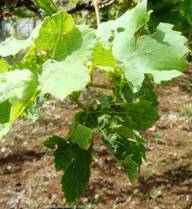 |
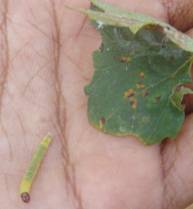 |
| Skeletonization |
Scrabbing of leaves |
|
| Identification of pest |
- Larva - Pale green with short hairs.
- Adult - Brownish moth with wavy line.
|
|
Sphingid, Hippotion celerio
| Identification of pest |
- Larva - Stout and green with an anal horn.
- Adult - Robust, red and brown coloured moth.
|
|
SAP FEEDERS
Thrips
| Symptoms of damage |
- Presence of silvery white scorchy patches on the leaves.
- Veins without fruits
- Premature fruit drop
|
| Identification of pest |
- Nymphs - yellowish brown colour and red colour abdomen
- Adult - black brownish abdomen and yellowish wings
|
 |
| Adult |
|
| Management |
-
Collect and destroy damaged leaves, fruits and flowers
-
Insecticides: methyl demeton 25 EC 0.05% or dimethoate 30 EC 0.06%
|
Mealy bug Ferrisia virgata
| Identification of pest |
- Nymph - Yellowish to pale white.
- Adult - long, slender covered with white waxy secretions
|
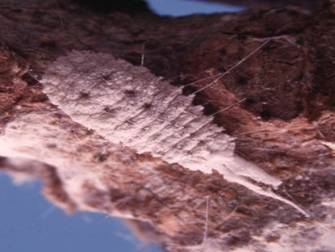 |
| Adult |
|
| Management |
-
Debark vines and branches and apply methyl parathion paste
-
Collect damaged bark, leaves, twigs and stems
-
Use sticky traps on fruit – bearing shoots at a length of 5 cm
-
Use dichlorvos 76 WSC 0.15% in combination with fish oil rosin soap (25g//)
-
Soil application of aldicarb 10 G/ vine around the base at time of pruning
-
Insecticides
- dimethoate 30 EC plus kerosene oil at 150 ml plus 250 ml in 100 ml of water
- Apply quinalphos or methyl parathion dust in the soil at 25 kg/ ha to kill ants
- Release exotic predator, Cryptolaemus montrouzieri @ 10 beetles/vine
- Field release of parasitoids - Anagrus dactylopii, Gyanusoidea mirzai
|
Mealy bug, Maconellicoccus hirsutus
| Symptoms of damage |
-
Nymphs and adults suck the sap from leaves, shoots and fruits
-
Honey dew – development of sooty mould on leaves, shoots and branches
-
Crinkling and yellowing of leaves
-
|
| Identification of pest |
- Nymph - pinkish in colour.
- Adult – pink colour and covered with white wax
|
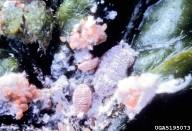 |
| Pink mealy bug |
|
| Management |
-
Apply quinalphos or methyl parathion dust in the soil @ 20 kg/ha to kill the ants.
-
Spray methyl demeton 25 EC or monocrotophos 36 WSC at the rate of 2 ml/lit of water
-
Spray dichlorvos 76 WSC at the rate of 1 ml/lit with fish oil rosin soap at 25 g/lit.
-
Release Coccinellid beetle, Cryptolaemus montrouzieri at the rate of 10 per vine.
|
Berry plume moth, Oxyptilus regulus
| Symptoms of damage |
-
Early instar larvae web the flower buds
-
Matured larvae attack bunch of fruit
-
Caterpillar bore into green berry fruit and tunneling
-
Feeds on internal content
-
Affected berries – known as “stung berries”
|
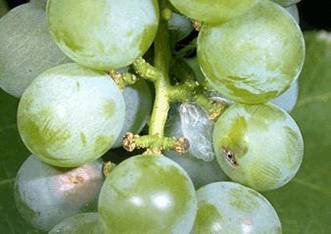 |
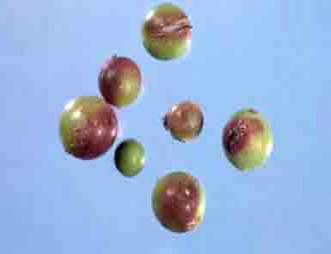 |
| Larva attack grape bunch |
Affected berries (stung berries) |
|
| Identification of pest |
- Larva - Small, pale green or pink with median red line.
- Adult - Small moth.
|
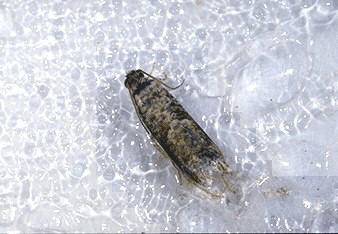 |
| Adult |
|
| Management |
-
Collect and destroy the infested leaves and buried with soil
-
Summer ploughing – kill the pupae
-
Use pheromone trap to attract male and kill the adult
-
Spot application of bubrofezin and acetemprid for effective manage this pest
|
|

